The Boab Tree - Our Kimberley Icon
To see a boab tree you have to visit the Kimberley!
The only place in the world to find the unusual boab tree is the Western Australia Kimberley region.
But here they are everywhere!
Coming from Darwin/Katherine you will see the first trees as you approach the Victoria River and Gregory National Park.
Across the Kimberley, through Kununurra and all the way to Broome boabs are a common sight.

Every boab tree is unique. They have character and personality as you would expect of such an ancient creature. Some individual boab trees are 1500 years old and older, which makes them the oldest living beings in Australia, and puts them amongst the oldest in the world.
Aboriginals used the giants as shelter, food and medicine. For the white settlers they served as easily recognisable land marks and meeting points, and not to forget as impromptu prison cells.
Read about the many uses of the boab tree, in the past and in the present:
Boab Tree Facts | Boabs as Food | Boab Nut Carving | Prison Boabs
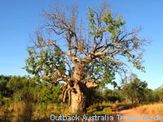
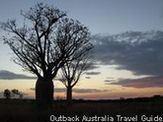
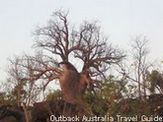
Boab Tree Facts
The Australian boab tree (Adansonia gregorii) is related to the Madagascan and African Adansonia species known as baobabs. Like its relatives it is sometimes called a "bottle tree", but we locals refer to the trees as just boabs.
There are two theories about how boab trees arrived in Australia. One says the seeds have floated here from Africa and spread from the coast. The other theory suggests boabs might have survived from the time when Africa and Australia were both still part of one continent, the ancient Gondwana, 65 million years ago.
A mature boab tree is a sight to behold. Though not exceptionally high, up to 15 metres, they appear huge. The name bottle tree relates to the swollen trunk that can reach a massive girth of up to 20 metres.
The boab is a very slow growing tree and it takes many hundred if not thousand years to grow into one of those impressive specimen. The images below show boab trees at different ages, 5, 50 and 500 years:
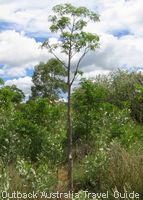
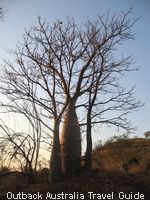
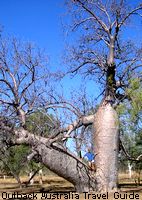
Ok, I made that up, I have no idea how old these trees are. Let's say young, middle aged and old.
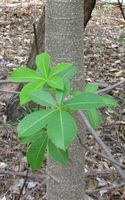
The bark of the boab tree is grey brown and very smooth, the leaves have 5 to 9 longish leaflets.
Boab trees are deciduous, they drop all their leaves during the dry season. Since the dry season is the main tourist season most travellers only get to see the grey brown skeletons.
When the wet season approaches the trees sprout new leaves. Every year I am amazed at how the trees know that rain is coming. They are already covered in lush green when the first rains arrive...
Boab trees flower and fruit in the wet season. Flowering can start as early as October and the flowers are gorgeous. Big, white, with a pinkish hue, intricate and fragrant. The fruit starts setting around January.
Mature "boab nuts" are woody capsules of varied shapes and can reach enormous size. Most of them are kind of oval, but they can also be round and squat, very long and pointed, or simply weird shaped.
The nut is covered in fine hair of a light olive to brownish colour, which can easily be scraped off to reveal the dark brown of the boab nut itself.
When the nuts fall on the ground they often break open to reveal several kidney shaped seeds inside the white pith.
Seeds, pith, in fact most parts of the tree are edible. More on this below.
Boab Trees As Food
All Adansonia species, Australian and African, have long been used as a staple food source by the indigenous populations. Studies on the African species have shown parts of the tree to be exceptionally high in Vitamin C, more than ten times the Vitamin C content of oranges! The Australian boab tree is not as well studied, but it is known that the seeds are very high in Vitamin C as well.
In the past edible Australian plants were called "bush tucker" and seen as a curiosity and as survival food, something you'd eat when you get lost or similar... Thank god that's slowly changing. The interest in Australian native flora as a hardy food crop has been increasing and Australian bush foods have come a long way since the early experiments by some adventurous chefs and food enthusiasts.
Boab trees are now grown commercially in the Kimberley and sold as a gourmet food, (tough you will probably have problems tracking some down). Interestingly it's not the nuts or the leaves that get all the attention. No, it's the boab tree root, (although the young leaves are nice in salads, too).
When commercially grown boab trees are harvested at about 6 - 8 weeks of age their root has the size and shape of a big carrot, very big actually for the little tree top it supports. Like carrots they are sold in bundles with the tops still attached, and are peeled, then sliced or grated.
And let me tell you, boab tree roots are delicious (I'm lucky enough to be friends with the only commercial growers of boab roots...). Similar in texture to water chestnuts, and sweet and crunchy like the core of a carrot.
If you want to taste fresh boab root try Paddy's Market in Kununurra (in Whitegum Park on Saturday mornings during the dry season). Growers Peter Fox and Denise Hales offer free tasters and sell all kinds of boab delicacies from their stall.
If you'd like to know more about boab roots, like where to buy them and what to do with them, watch this space. I will add more information soon (Denise is currently compiling a recipe booklet). Or even easier, subscribe to my RSS feed and you will be notified! (See the box below the navigation buttons at the top left for more info on RSS.)
A word of warning: boab trees are a protected species. You are not allowed to gather seedlings or seeds from the wild!
Boab Trees and Aboriginal Art
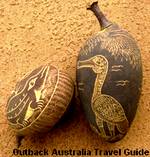
Today many Aboriginal artists of the Kimberley use boab tree nuts for carvings and paintings.
When the dark surface of the boab nut is scratched away it reveals a light colour underneath.
(Btw, the nuts in the photo are not examples of exceptional artwork... but they show how it works.)
Large and regular shaped nuts are more popular but the smaller nuts are used, too. What is most important is the time of harvest. The nut has to dry on the tree, but needs to be picked rather than fall on the ground where it will most likely crack.
Motives include highly detailed faces, usually the much lined faces of Aboriginal elders, and native animals like snakes, kangaroos, birds and others, set in local landscapes.
Individual artists have individual styles, the preferred motives and the preferred nut shape vary. The colour, size and hardness of the nuts depends on the location of the tree... A carved boab nut is intimately connected to the region where both the artist and the tree grew up... What better souvenir to take home from the Kimberley?
Prison Boab Trees
This is the famous Prison Boab near Derby at the west coast.
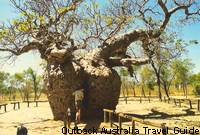
The hollow tree trunk has a circumference of over 14 metres and the door is a metre wide and two metres high. It was used as a "prison cell" in the 1890s by the local police to lock up Aboriginal prisoners over night, on their way to Derby for sentencing. You can find it 7 km out of Derby, just beyond the Gibb River Road turn off.
Another prison boab tree of similar age and size is located near Wyndham at the eastern end of the Kimberley. It can be found 23 kilometres along the King River Road. Despite the grand name the road is only a rough bush track, hence the tree is not as well known as the easily accessible Derby tree.
The remarkable Wyndham boab tree has a circumference of 14.7 metres and is estimated to be at least 1500 years old. Like the Derby tree it was used by local police as an overnight lock up. The tree was an obvious choice for an overnight stop. It's a day's travel from Wyndham (in the old days, that is, when travel was on horse back) and water is found near by.
The Wyndham prison boab tree is of cultural significance to the local Aboriginals. It is fenced off and travellers are asked not to approach it.
Read more about the Kimberley in Australia
Return to Outback Australia Travel Guide home page





